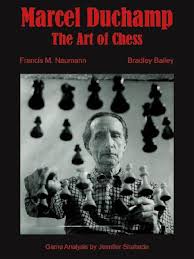

Marcel DuchaMarcel Duchamp and Chess: The Art of Strategic Thought
Marcel Duchamp, one of the most influential artists of the 20th century, is often associated with groundbreaking works like the provocative «Fountain» and the enigmatic «Nude Descending a Staircase.» Yet, beyond the realms of canvas and sculpture, Duchamp’s life took an unexpected turn into the world of chess, a game that captivated his intellect and inspired his artistic philosophy.
Chess as a New Canvas
Duchamp’s transition from the art world to chess was not a sudden shift but a gradual evolution. By the early 1920s, he had become deeply engrossed in the game, viewing it as a form of intellectual and aesthetic expression. «Chess is a pure thing,» Duchamp once remarked, highlighting its abstract nature and the beauty of its logical structures.
For Duchamp, chess mirrored the essence of art—a creative process that transcended physical materials. He believed that the mental rigor and strategic depth required in chess paralleled the innovation and thoughtfulness essential to creating art. In a way, chess became his new medium, allowing him to explore ideas of space, movement, and time without the constraints of traditional artistic tools.
Competing on the Board
Duchamp was not just a casual chess enthusiast; he pursued the game with the seriousness of a professional. He competed in tournaments, represented France in Chess Olympiads, and even achieved the title of chess master. His dedication to chess was so profound that he once declared, “I am still a victim of chess. It has all the beauty of art—and much more.”
His commitment to chess led him to withdraw from the art world almost entirely, leaving many of his contemporaries puzzled and some even dismayed. But for Duchamp, the intellectual challenges of chess offered a fulfillment that traditional art could no longer provide.
Chess in Duchamp’s Art
Though Duchamp largely stepped away from creating traditional artworks, his passion for chess influenced some of his later projects. One notable example is his design of the 1924 film «Entr’acte,» directed by René Clair, in which Duchamp appears playing chess. Additionally, he collaborated with Man Ray to create «Portrait of Chess Players,» a photograph that reflects his deep connection to the game.
Duchamp also designed unique chess sets, blending his artistic sensibilities with his love for the game. These sets, minimalist and modernist in design, demonstrate his belief that the aesthetic experience of chess extends beyond the board and into the very tools used to play.
The Legacy of Duchamp’s Chess Journey
Marcel Duchamp’s immersion in chess challenges the traditional boundaries between art and life. By dedicating himself to the game, he exemplified a life lived in pursuit of intellectual and creative freedom. His journey serves as a reminder that art is not confined to galleries and museums; it can be found in the patterns of a chessboard, the strategies of a game, and the passion of a player.
Today, Duchamp’s dual legacy as an artist and a chess enthusiast continues to inspire. His life invites us to see connections between disciplines and to recognize that creativity knows no bounds. Whether on a canvas or a chessboard, Duchamp’s spirit endures as a testament to the power of imagination and the beauty of strategic thought.
Further Reading and Discussions:
The Intersection of Art and Chess – Medium
Marcel Duchamp and Chess on Wikipedia
Duchamp’s Chess Journey on Chess.com
Why Did Marcel Duchamp Abandon Art for Chess? – Quora
Marcel Duchamp’s Chess Obsession – Reddit Discussion

